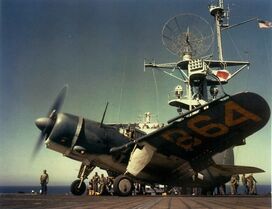The Curtiss SB2C Helldiver (known as the A-25 Shrike in USAAF service) was a carrier-borne dive bomber first flown in late 1940 and used mainly by the United States Navy.
Description[]
Requiring a crew of 3, the aircraft was powered by a single Wright R-2600-8 Cyclone radial engine. Armament consisted of two or four 12.7mm machine guns, two 7.62 mm Browning M1919s, and a payload of either up to 1,360 kilograms of bombs or 1 Mk. 13 torpedo.[1]
Designed to replace the SBD Dauntless, the SB2C Helldiver was faster, more heavily armed, and had a larger payload, although, the Helldiver did have several drawbacks compared to the Dauntless. Chief among these was that fact that it had troublesome handling traits, which made it very unpopular originally among crews.
The SB2C had a maximum service ceiling of 8,800 meters and an operational range of around 1,770 kilometers. It could travel at speeds of up to 474 kilometers per hour and had a cruising speed of 254 kilometers per hour. The total weight of the Helldiver was 4,700 kilograms. Total length was 11.1 meters with a wingspan of 15.1 meters.
Variants[]
The first real variant of the Helldiver series was the SB2C-1C which sported two 20mm autocannons mounted in place of the original four 12.7mm machine gun armament. The SB2C-3 was given an upgraded engine which increased performance while the SB2C-4 was given the capability to mount underwing rockets. This variant had a sub-variant of its own designated the SB2C-4E which was similar but it had a special radar system installed. The final variant of the Helldiver series was the SB2C-5 which had several minor improvements but most important among all of these was an increased fuel supply.
History[]
Development[]

An SB2C about to takeoff from its carrier deck
The SB2C was developed by a group led by Raymond C. Blaycock, in response to a comprehensive 1938 specification for a carrier based scout bomber, which demanded an aircraft featuring; cantilever monoplane wing and stressed skin construction able to withstand dive bombing attacks. Furthermore, the aircraft was required to have internal weapon bay capable of carrying a 1,000 lb (454 kg) bomb and a wide range of other stores, and fitted with hydraulically operated doors, tandem accommodation for two crew members, Enough fuel for prolonged operations, comprehensive equipment including a radio system, as well as a large camera in the rear cockpit, full carrier compatibility - folding wings, catapult hooks and an arrester hook, and a single 14 cylinder Wright R-2600 Cyclone radial engine.[2]
Curtiss responded with the XSB2C-1 (BuNo. 1758), which was ordered on 15 May 1939 and first flew on 18 December 1940. By this time the US Navy had decided to order 200 SB2C-1 aircraft, placing this order on 29 November 1940. This led to Curtiss creating a new plant at Columbus in Ohio, while setting up two other production lines at Canadian Car & Foundry at Fort William, and Fairchild Aircraft at Longueil in Monteral, despite the fact that the SB2C was riddled with faults.
Minor faults included problems with the engine and the Curtiss-Electric propeller. Major faults included structural weaknesses, poor handling and unacceptable stall characteristics. The type also suffered violent changes in trim following application of flaps or dive brakes, operation of the landing gear or changes in engine setting.[2]
The XSB2C-1 was extensively redesigned and rebuilt following a crash caused by engine failure on 8 February 1941. The fuselage was lengthened by 1 ft (0.305 m), tail size was increased by 30 percent, self-sealing fuel tanks were placed in the fuselage and inner wings, local armour was added and the two M2 Machine Guns in the cowling being replaced with four M2s in the wings.[N 1] In addition, the rear cockpit was fitted with collapsible decking to improve the field of fire of the observer's single M2 Machine Gun.[N 2]
Service[]
The first unit to equip with the SB2C was Scouting Squadron 9 (VS-9), who began receiving the type from December 1942, although it was not deemed suitable for combat until 11 months later, when Bombing Squadron 17 (VB-17) first used the type in combat by launching a strike against the Japanese base at Rabul on 11 November 1943.[N 3] The mission resulted in the loss of four SB2Cs - one lost on take off, one shot down by a Japanese fighter, one lost to AAA and one that was shoved overboard after it crashed upon landing due to battle damage.[3]
The various versions of the SB2C consistently topped the US Navy accident league table, leading to the aircraft becoming know as 'The Beast', with many in the Navy suggesting that the SB2C designation stood for 'Son of a B****, 2nd Class.[2]
Notes[]
- ↑ These last three modifications were prompted by combat reports from Europe[2]
- ↑ This was later replaced with a pair of Browning M1919s with 2,000 rounds each.[2]
- ↑ The unit's work up in early 1943 had resulted in the loss of several aircraft and their crews, leading to suggestions that VB-17 should revert to the SBD for it's combat cruise.[3]
References[]
| |||||||||||||||||||||||
